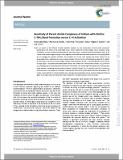Por favor, use este identificador para citar o enlazar a este item:
http://hdl.handle.net/10261/184843COMPARTIR / EXPORTAR:
 SHARE SHARE
 CORE
BASE CORE
BASE
|
|
| Visualizar otros formatos: MARC | Dublin Core | RDF | ORE | MODS | METS | DIDL | DATACITE | |

| Título: | Reactivity of parent amido complexes of iridium with olefins: C−NH2 bond formation versus C−H activation |
Autor: | Mena, Inmaculada CSIC; García-Orduña, Pilar CSIC ORCID; Polo, Víctor CSIC ORCID; Lahoz, Fernando J. CSIC ORCID; Casado, Miguel A. CSIC ORCID; Oro, Luis A. CSIC ORCID | Fecha de publicación: | 2017 | Editor: | Royal Society of Chemistry (UK) | Citación: | Dalton Transactions 46(34): 11459-11468 (2017) | Resumen: | Herein we report on the different chemical reactivity displayed by two mononuclear terminal amido compounds depending on the nature of the coordinated diene. Hence, treatment of amido-bridged iridium complexes [{Ir(μ-NH2)(tfbb)}3] (1; tfbb = tetrafluorobenzobarrelene) with dppp (dppp = bis(diphenylphosphane)propane) leads to the rupture of the amido bridges forming the mononuclear terminal amido compound [Ir(NH2)(dppp)(tfbb)] (3) in the first stage. On changing the reaction conditions, the formation of a C-NH2 bond between the amido moiety and the coordinated diene is observed and a new dinuclear complex [{Ir(1,2-η2-4-κ-C12H8F4N)(dppp)}2(μ-dppp)] (4) has been isolated. On the contrary, the diiridium amido-bridged complex [{Ir(μ-NH2)(cod)}2] (2; cod = 1,5-cyclooctadiene) in the presence of dppb (dppb = bis(diphenylphosphane)butane) allows the isolation of a mononuclear complex [Ir(1,2,3-η3-6-κ-C8H10)H(dppb)] (5), as a consequence of the extrusion of ammonia. The monitoring of the reaction of 2 with dppb (and dppp) allowed us to detect terminal amido complexes [Ir(NH2)(P-P)(cod)] (P-P = dppb (6), dppp (7)) in solution, as confirmed by an X-ray analysis of 7. Complex 7 was observed to evolve into hydrido species 5 at room temperature. DFT studies showed that C-H bond activation occurs through the deprotonation of one methylene fragment of the cod ligand by the highly basic terminal amido moiety instead of C-H oxidative addition to the Ir(i) center. | Versión del editor: | https://doi.org/10.1039/C7DT01924F | URI: | http://hdl.handle.net/10261/184843 | DOI: | 10.1039/C7DT01924F | ISSN: | 1477-9226 | E-ISSN: | 1477-9234 |
| Aparece en las colecciones: | (ISQCH) Artículos |
Ficheros en este ítem:
| Fichero | Descripción | Tamaño | Formato | |
|---|---|---|---|---|
| reactiactiva.pdf | 601,41 kB | Adobe PDF |  Visualizar/Abrir |
CORE Recommender
SCOPUSTM
Citations
3
checked on 14-may-2024
WEB OF SCIENCETM
Citations
3
checked on 26-feb-2024
Page view(s)
158
checked on 12-may-2024
Download(s)
145
checked on 12-may-2024
Google ScholarTM
Check
Altmetric
Altmetric
NOTA: Los ítems de Digital.CSIC están protegidos por copyright, con todos los derechos reservados, a menos que se indique lo contrario.
